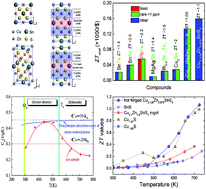Colossal thermoelectric enhancement in Cu2+xZn1−xSnS4 solid solution by local disordering of crystal lattice and multi-scale defect engineering†
Abstract
Polycrystalline sulfides are promising thermoelectric materials because of their abundance, non-toxicity, and low cost. However, their low thermoelectric performance hampers their possible large-scale industrial application. In this work, Cu self-doping in Cu2+xZn1−xSnS4, prepared using a simple processing route, realizes the decoupling of thermal and electric transport as follows. The additional copper ions occupy Zn sites and provide more carriers, which leads to excellent hole conductivity. Moreover, when x is above 0.125, the content of Cn/Zn disordered sites is beyond the percolation threshold (∼0.3) of thermal diffusivity. A maximum power factor (450 μW m−1 K−2) is obtained for Cu2.125Zn0.875SnS4. Combined with ultra-low specific heat below the theory predicted minimum for structural disordering on the copper and zinc sites, the κ of the material reduces to 0.22 W m−1 K−1 at 773 K, which is minimum in thermoelectric materials up to now. Moreover, hot forging (deformation strain ∼64% and maximum of displacement rate ∼18 mm min−1), a dynamic plastic deformation process, was employed to produce defects on different length scales (point defects, dislocations, stacking faults and deformation twins), that optimize the power factor and lattice thermal conductivity. Based on the above synergistic effects, a high ZT value of 1.1 has been achieved in Cu2.125Zn0.875SnS4 ceramics, and there is 18-fold increase in ZT value compared with that of conventionally processed intrinsic Cu2ZnSnS4.



 Please wait while we load your content...
Please wait while we load your content...